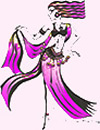Ethnic Dance Expressions School of Belly Dance Gainesville, Florida Classroom Tips for Studying
Belly Dancing Successfully
 Your body is an instrument that has to be finely tuned. How long it takes will vary from individual-to-individual. There is no magic date or set time when everything will fall into place for you. It will happen only after you have done all the necessary preparations. Every good dancer you see was once a beginner and went through every thing you are feeling and going through. However, here are some things you can do to make your class and practice efforts more rewarding and help insure your success.
Your body is an instrument that has to be finely tuned. How long it takes will vary from individual-to-individual. There is no magic date or set time when everything will fall into place for you. It will happen only after you have done all the necessary preparations. Every good dancer you see was once a beginner and went through every thing you are feeling and going through. However, here are some things you can do to make your class and practice efforts more rewarding and help insure your success.
Sallamah Chimera's 10 Classroom Tips
- Attend Class Regularly. For every class you miss, it takes two classes to make it up. If you are a new or slow learner, poor attendance will have a negative impact on your progress. If possible, take two classes a week. The second class will act as a review of what you learned earlier and help reinforce your newly found dance skills. Dance muscle proficiency and coordination is built by constant repetition. It takes 70,000 repetitions to place a movement or isolation in your muscle memory.
- Position yourself close to the teacher. The closer you are to your teacher, the fewer distractions there will be and you will be able to see and hear her better.
- Keep changing places in class so you can see the instructor and dance movements from different angles. This will also help you when you dance so you don't stay in one area of the stage--the same area you stand in when taking class!
- Dress appropriately. Don't wear clothes that restrict or obscure your movements, don't give you proper support or are uncomfortable. In Florida, wear layers so you can take off or put on clothes as you need to adjust to the temperature and humidity.
- Take notes. The process of taking notes employs the same parts of the brain required to learn how to dance. Learning to dance isn't all physical. It is a mind-body process. It is hard to remember everything when you get home. Refer back to your notes when you practice at home. (You can develop a vocabulary for yourself to help you remember the names of movements your teacher is using. And this will force you to analyze what you are doing and help you learn or correct your movements.)
- Practice, Practice, Practice! At home, in front of the copier at work, while cooking dinner, anywhere and any time you get a chance. A minium of 30 minutes a week will help you. Work on basic isolations and your posture if not on actual dance technique and choreography.
- Think about the basic movements you learn each week in class and how to do them beginning with the head all the way down to your hips and even dance walks with your feet. Make a list or if your teacher has a technique video, use that to help you practice. Looking at You Tube probably will confuse you more than help you in the beginning. You need to learn what your instructor is teaching you because that is what you will be working with.
- To understand movement, look at the line, direction and shape of the movement. Is it horizontal, vertical, circular, or on the diagonal? Does it lift or drop or twist? Does it follow a straight line or weave or curve? What muscles are used to execute it? What are your feet, knees, hips and torso doing? What are your shoulders, arms, hands and chest doing? Does the movement move away from your body or happen inside your body?
- Know your learning style. Are you a Visual, Auditory, Cerebral or Tactile/Kinesthetic learner? Are you a combination of several? Find a teacher who understands the various learning styles and incorporates the appropriate verbal explanations, physically demonstrates the movements, draws or diagrams what she/he is teaching, and writes out descriptions of technique and choreography. Find a teacher that understands dyslexia and extreme left-handedness if you have problems with either.
- Get a Dance Bag and Get Organized. To have a successful class, you have to bring your tools with you. If you went to the kitchen and it was empty of the tools and ingredients you needed to make a cake, you wouldn't have much success. The same applies to dancing. Your dance bag should contain your hip scarf, zills, veils, dance shoes, notebook and pen and other items your teacher has asked you to bring.
 Ethnic Dance Expressions
Ethnic Dance Expressions